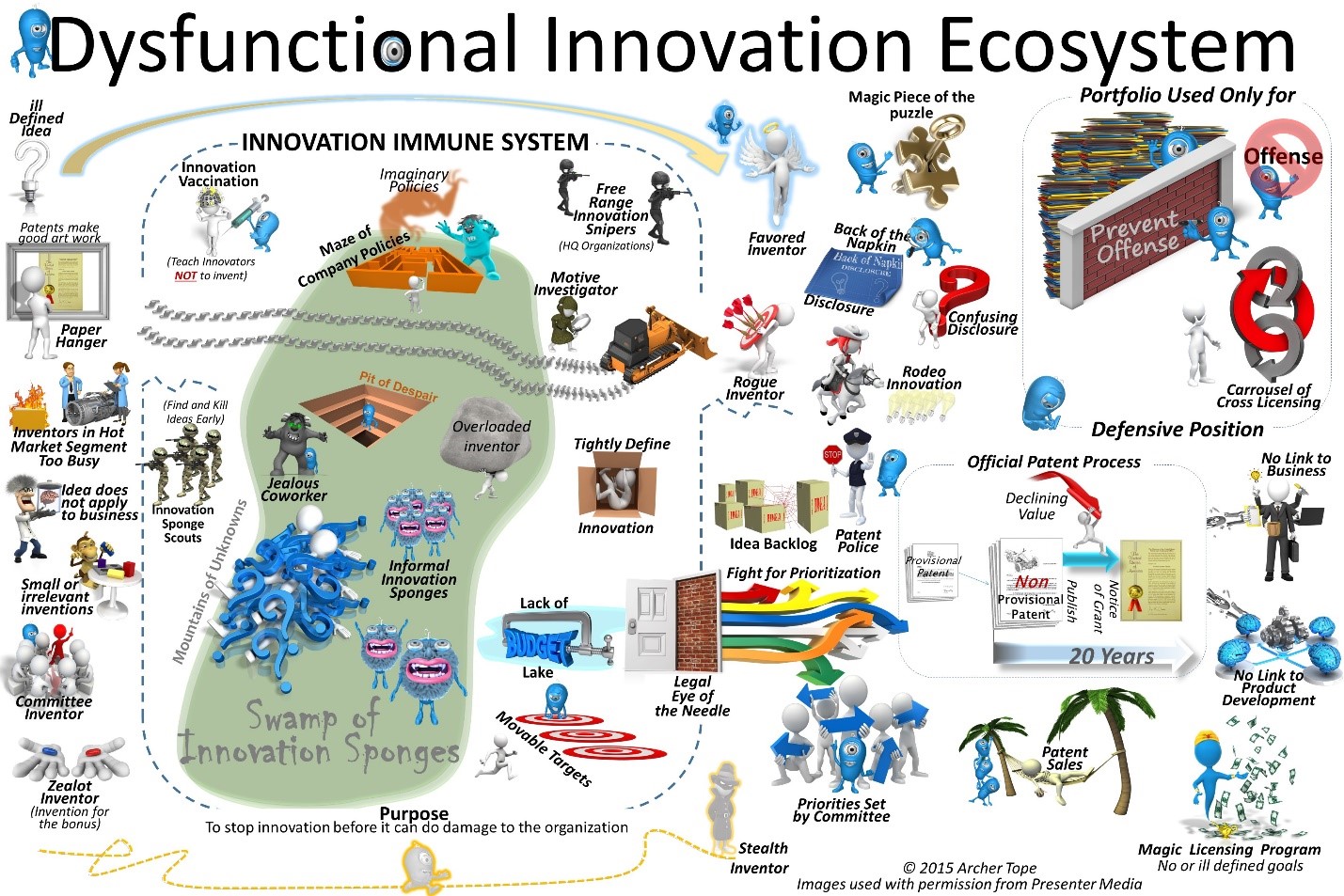The Dysfunctional Innovation Ecosystem
We naturally think an ecosystem should be positive or encouraging toward their end goal and naturally evolve to support their stated purpose. However, innovation tends to be different. If left unchecked or allowed to evolve on its own, innovation within an organization tends to become an innovation prevention program instead of a positive ecosystem to encourage or nurture innovation. Without proper guidance organizations naturally tend to evolve an innovation immune system with its own (often unstated) goals, logic, and objectives.
The innovation immune system is often populated with innovation sponges throughout the organization. These innovation sponges slowly soak up innovative activities. This often sends a message to your inventors – “the deck is stacked against youâ€.
Small issues, activities, or hurdles tend to have a disproportional impact on the innovation ecosystem – both positive and negative. Keep in mind innovation is typically an extra on top of the employee’s other duties and activities. Also, keep in mind the employees you most likely want to participate in your innovation program are usually the busiest ones. The most sought after employees for other issues in your organization are also likely to also be the most sought after employees for new ideas.
The Innovation Immune System is much more insidious than just discouraging innovation in an organization; it actually vaccinates participants against future innovation. It trains innovators and others that it is not good to come up with new ideas. There is no map for the maze you must navigate. In general the Innovation Immune System sets up an environment where innovation is discouraged.
 If you place impediments on the path of innovative employees, it can have a disproportionate impact on their involvement in your innovation. When numerous small hurdles are placed in the path of innovators, they tend to just go back to their regular full-time jobs. When, through your behavior, you indicate an extra duty like innovation is desirable, you will likely be amazed at the impact. This is true for even a small incentive, benefit, or reward.
If you place impediments on the path of innovative employees, it can have a disproportionate impact on their involvement in your innovation. When numerous small hurdles are placed in the path of innovators, they tend to just go back to their regular full-time jobs. When, through your behavior, you indicate an extra duty like innovation is desirable, you will likely be amazed at the impact. This is true for even a small incentive, benefit, or reward.
The infographic for the dysfunctional innovation ecosystem tends to over-exaggerate some of these issues, however, these are real issues that arise in many organizations. If left unchecked they tend to have a major impact on innovation in your company. The infographics assigns interesting and memorable names to many of these inappropriate behaviors. This allows you to easily remember them, call them by their name, and remain vigilant against innovation sponges growing in your organization or innovation programs.
For Pro Tips on how to cure the Dysfunctional Innovation Ecosystem – read “Pro Tips and Tricks for Innovation and Patents†now available on Amazon.
About the Author
My name is Archer Tope – this is a pseudonym or Nom de Plume if you prefer. The reason for the use of this subterfuge is to protect my true identity while I continue to work in the innovation and intellectual property field. I have been involved in or around innovation for at least 20 years. I decided to write this book because I found some individuals and entities tend to view innovation as more of a hobby instead of a true vocation. This has always bothered me because there is a method to implement an effective innovation program – and it works.
I have over 70 domestic US and international patents to my name. Many of my patents have been sold or used to develop products and companies which were sold to others. I have been involved with startups which have had public exits, got caught in stock market crashes, acted as an expert witness in a patent litigation, sold patent portfolios, helped structure new innovation programs, negotiated innumerable contracts, run development teams, and sued a Fortune 50 company for patent infringement. My view of the innovation landscape may be broad, however, I have also dealt in the details.
NEVER MISS ANOTHER NEWSLETTER!
LATEST BLOGS
How Brexit Has Affected UK E-commerce Businesses
Photo by Zyro on Unsplash The popularity of online shopping was already growing at an impressive rate – and…
Read MoreOvercoming range anxiety: three tips for EV owners
Photo by Jenny Ueberberg on Unsplash In the last few years, electric vehicles (EVs) have become more and more…
Read More







